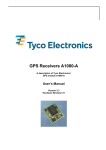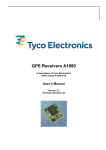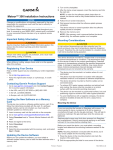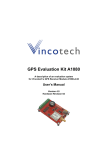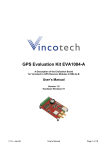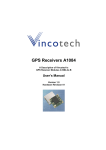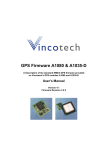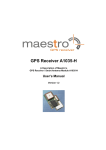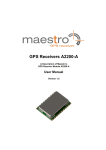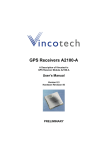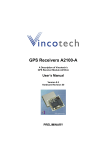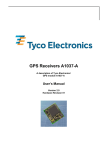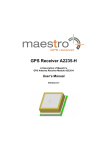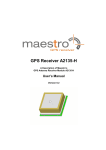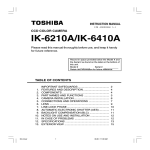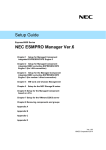Download GPS Receiver A1080
Transcript
GPS Receiver A1080 A Description of Vincotech’s GPS Receiver Module A1080-A/-B User’s Manual Version 4.2 Hardware Revision 04 Revision History Rev. 1.0 1.1 1.2 1.4 2.0 2.1 2.2 2.3 3.0 3.1 3.2 4.0 4.1 Date 10-18-06 12-04-06 12-08-06 03-13-07 03-23-07 06-01-07 07-03-07 06-07-07 07-23-07 10-08-07 03-05-08 08-04-08 11-14-08 4.2 07-07-09 Description Initial Draft. First released revision Application note: Antenna current limiter Some minor changes and updates New design, adjustments Correction solder pads size Minor updates serial port configuration Application note: reset pin Hardware revision 2; PTF function implemented Minor style corrections; review; combination of –A and –B versions Format corrections HW rev. 03 introduced; new layout; moved to Vincotech HW version 02 & 03 deleted, HW version 04 added, DC Electrical Characteristics added, Hybernate Mode added, link to 1PPS application note and 1PPS timing accuracy remarks added, contact details (email addresses) corrected, storage temperature corrected, minor changes Additional note on Tracking Sensitivity regarding antenna; added hint about Ephemeris Push in FW 3.5.0; corrected reflow soldering profile mm-dd-yy V4.2 - Jul-09 User’s Manual Page 2 of 31 Disclaimer THIS DOCUMENT CONTAINS PROPRIETARY INFORMATION OF VINCOTECH GMBH. IT MAY NOT BE COPIED OR TRANSMITTED BY ANY MEANS, PASSED TO OTHERS, OR STORED IN ANY RETRIEVAL SYSTEM OR MEDIA, WITHOUT PRIOR CONSENT OF VINCOTECH OR ITS AUTHORIZED AGENTS. THE INFORMATION IN THIS DOCUMENT IS, TO THE BEST OF OUR KNOWLEDGE, ENTIRELY CORRECT. HOWEVER, VINCOTECH CAN NEITHER ACCEPT LIABILITY FOR ANY INACCURACIES, OR THE CONSEQUENCES THEREOF, NOR FOR ANY LIABILITY ARISING FROM THE USE OR APPLICATION OF ANY CIRCUIT, PRODUCT, OR EXAMPLE SHOWN IN THE DOCUMENT. THE PRODUCT (HARD- AND SOFTWARE) DESCRIBED IN THIS DOCUMENTATION IS NOT AUTHORIZED FOR USE IN LIFE SUPPORT DEVICES OR SYSTEMS WITHOUT THE EXPRESS WRITTEN APPROVAL OF VINCOTECH. THIS DOCUMENT MAY PROVIDE LINKS TO OTHER WORLD WIDE WEB SITES OR RESOURCES. BECAUSE VINCOTECH HAS NO CONTROL OVER SUCH SITES AND RESOURCES, VINCOTECH SHALL NOT BE RESPONSIBLE FOR THE AVAILABILITY OF SUCH EXTERNAL SITES OR RESOURCES, AND DOES NOT ENDORSE AND IS NOT RESPONSIBLE OR LIABLE FOR ANY CONTENT, ADVERTISING, PRODUCTS, OR OTHER MATERIALS ON OR AVAILABLE FROM SUCH SITES OR RESOURCES. VINCOTECH SHALL NOT BE RESPONSIBLE OR LIABLE, DIRECTLY OR INDIRECTLY, FOR ANY DAMAGE OR LOSS CAUSED OR ALLEGED TO BE CAUSED BY OR IN CONNECTION WITH USE OF OR RELIANCE ON ANY SUCH CONTENT, GOODS OR SERVICES AVAILABLE ON OR THROUGH ANY SUCH SITE OR RESOURCE. VINCOTECH RESERVES THE RIGHT TO CHANGE, MODIFY, OR IMPROVE THIS DOCUMENT OR THE PRODUCT DESCRIBED HEREIN, AS SEEN FIT BY VINCOTECH WITHOUT FURTHER NOTICE. V4.2 - Jul-09 User’s Manual Page 3 of 31 Table of Contents 1 Introduction ........................................................................................................ 6 1.1 Label ................................................................................................................. 6 1.2 Characteristics .................................................................................................. 7 1.2.1 GPS Characteristics ................................................................................................... 7 1.2.2 Mechanical Characteristics......................................................................................... 7 1.3 Handling Precautions ........................................................................................ 7 2 Ordering Information ......................................................................................... 8 2.1 GPS Receivers A1080 ...................................................................................... 8 2.2 Packing of the A1080 ........................................................................................ 8 2.3 Additional Equipment ........................................................................................ 9 3 Quick Start........................................................................................................ 10 3.1 Minimum Configuration ................................................................................... 10 3.2 Antenna........................................................................................................... 11 3.3 Serial Port Settings ......................................................................................... 11 3.4 Improved TTFF ............................................................................................... 11 4 Mechanical Outline .......................................................................................... 12 4.1 Details Component Side A1080 ...................................................................... 12 4.2 Details Solder Side A1080 .............................................................................. 13 5 Pin-out Information .......................................................................................... 14 5.1 Layout A1080 (HW revision 04) ...................................................................... 14 5.2 Description A1080 Signals (HW revision 04) .................................................. 15 5.3 General Comments ......................................................................................... 16 6 Electrical Characteristics ................................................................................ 17 6.1 Operating Conditions ...................................................................................... 17 6.2 Absolute maximum ratings.............................................................................. 17 6.3 DC Electrical Characteristics........................................................................... 18 7 Mounting........................................................................................................... 19 7.1 Proposed Footprint for Soldering .................................................................... 19 7.2 Recommended Profile for Reflow Soldering ................................................... 19 8 Use of Antenna................................................................................................. 20 8.1 Connection of RF Signal ................................................................................. 20 8.2 Active Antenna ................................................................................................ 21 9 Quality and Reliability...................................................................................... 22 9.1 Environmental Conditions ............................................................................... 22 9.2 Product Qualification ....................................................................................... 22 9.3 Production Test ............................................................................................... 22 10 Applications and Hints .................................................................................. 23 10.1 Minimum Configuration ................................................................................. 23 10.2 Antenna Status Adaptation ........................................................................... 23 V4.2 - Jul-09 User’s Manual Page 4 of 31 10.2.1 Antenna Sensor...................................................................................................... 23 10.2.2 Antenna Sensor with Current Limiter...................................................................... 24 10.3 VANT Pin (antenna voltage input pin) ........................................................... 25 10.4 1PPS pin (1 pulse per second pin)................................................................ 25 10.5 Reset Signal.................................................................................................. 26 10.5.1 Internal reset circuit ................................................................................................ 26 10.5.2 External reset circuit ............................................................................................... 26 10.6 Battery Back-up............................................................................................. 27 10.7 Push-to-Fix Mode.......................................................................................... 28 10.8 Hibernate Mode............................................................................................. 28 11 Evaluation Kit EVA1080-A ............................................................................. 29 11.1 Contact.......................................................................................................... 30 11.2 Related Documents....................................................................................... 30 12 List of Figures ................................................................................................ 31 13 List of Tables .................................................................................................. 31 V4.2 - Jul-09 User’s Manual Page 5 of 31 1 Introduction Vincotech’s GPS modules A1080-A and -B are highly integrated GPS receiver modules that can be used as SMT components. They are capable of receiving signals from up to 20 GPS satellites and transferring them into position and timing information that can be read over a serial port. This new generation of GPS modules combines small size and high-end GPS functionality at low power consumption: • • • • • Operable at 3.3V / 23mA (typ.) @ 1fix per second Small form factor of 19 x 16.2 mm (0.75” x 0.64”) On board antenna supply voltage feed Single-sided SMD component, for reflow soldering Tape & reel packaging The difference between the “A” and the “B” version is the supported temperature range. While the “A” can be operated from -30°C to +85°C, the “B” version extends this range down to -40°C. The A1080-A and -B GPS receivers are available as off-the-shelf components, 100% tested and shipped in standard tape-and-reel package. 1.1 Label The A1080-A labels holds the following information: Figure 1: A1080-A label The A1080-B’s label shows a “B” instead of the “A”. V4.2 - Jul-09 User’s Manual Page 6 of 31 1.2 Characteristics The modules are characterized by the following parameters. 1.2.1 GPS Characteristics Channels Correlators Frequency Tracking Sensitivity (1) Position Accuracy Horizontal Position Accuracy Time To First Fix – TTFF (theoretical minimum values; values in real world may differ) Stand alone Stand alone Obscuration recovery (2) Hot start (3) Warm (4) Cold (5) 20, parallel tracking 200,000 plus L1 (= 1575 MHz) -159 dBm < 10 m CEP (SA off) < 2.5 m CEP (SA off) 0.1 s <1s < 32 s < 35 s Table 1: A1080 GPS characteristics (1) (2) (3) (4) (5) Typical with external active antenna – see also paragraph “ 3.2 Antenna” The calibrated clock of the receiver has not stopped, thus it knows precise time (to the µs level). The receiver has estimates of time/date/position and valid almanac and ephemeris data. The receiver has estimates of time/date/position and recent almanac. The receiver has no estimate of time/date/position, and no recent almanac. 1.2.2 Mechanical Characteristics A1080 Mechanical dimensions Length Width Height A1080 Weight 19mm, 0.75” 16.2mm, 0.64” 2.4mm, 0.095” 1.2g, 0.042oz Table 2: A1080 dimensions and weight 1.3 Handling Precautions The GPS receiver modules A1080-A/-B are sensitive to electrostatic discharge (ESD). Please handle with appropriate care. V4.2 - Jul-09 User’s Manual Page 7 of 31 2 Ordering Information 2.1 GPS Receivers A1080 The order number is built as follows: • • V23993A1080A-xxx V23993A1080B-xxx V23993 stands for Vincotech’s wireless and communication products, A1080A for the A1080-A module, A1080B for the A1080-B module. The “xxx” reflects the current firmware version. If no firmware version is noted in an order, the latest version will be provided. 2.2 Packing of the A1080 The A1080-A/-B GPS modules come in a tape and reel package suitable for pick and place machines. Figure 2: A1080 tape specifications (1) V4.2 - Jul-09 User’s Manual Page 8 of 31 Figure 3: A1080 tape specifications (2) 2.3 Additional Equipment V23993EVA1080A Evaluation Kit (including one module V23993A1080A) Table 3: Additional equipment A detailed description of the additional kit can be found in the according manuals. Note: There is no specific evaluation kit for the A1080-B, as evaluation kits are designed for demonstration purposes and testing. The GPS parameters for both modules are identical. V4.2 - Jul-09 User’s Manual Page 9 of 31 3 Quick Start In order to allow an easy and quick start with the modules A1080-A/-B, this chapter provides a short overview on the most important steps to receive NMEA messages with position information on a serial port. 3.1 Minimum Configuration The following picture shows a recommended minimum configuration for NMEA output and commands sent and received via an RS232 interface based on the GPS module A1080-A (identical for A1080-B). Figure 4: Recommended minimum configuration A1080 Remarks: • Place C1 to C5 (here: 0.1µF) close to MAX3232. For capacity values see datasheet of actual component used. • Use 3.3V level shifter (MAX3232 or equivalent). • Use separate ground plane for antenna ground. • Antenna input impedance is 50Ohm. Match as close as possible. • Maximum allowed antenna current is 50mA. Consider a current limiter. (see chapter: 10.2.2 Antenna Sensor with Current Limiter) • A battery back-up circuit for the RTC (Real Time Clock) should be considered (see chapter: 10.6 Battery Back-up) NOTE: Please make sure the A1080-A/-B is mounted either electrically shielded or at least protected from direct airflow. This avoids degradation of GPS performance generated by temperature fluctuations. (see GPS AppNote RF-shield A1080) V4.2 - Jul-09 User’s Manual Page 10 of 31 3.2 Antenna It is recommended to use an active GPS antenna with supply voltage of 3 to 5VDC and a current draw of 50mA maximum. The quality of the GPS antenna chosen is of paramount importance for the overall sensitivity of the GPS system. An active antenna should have a gain ≥ 20dB and a noise figure ≤ 1.5dB, which applies to more than 95% of the active antennas available in the market. 3.3 Serial Port Settings The default configuration within the standard GPS firmware is: • Serial 0 (NMEA) 4800 baud, 8 data bits, no parity, 1 stop bit, no flow control 3.4 Improved TTFF In order to improve the TTFF (Time To First Fix), it is recommended to support the RTC with a back-up power supply when no system power is available (see chapter: 10.6 Battery Back-up). Furthermore, starting with FW revision 3.5.0 “Ephemeris Push” is supported. Please see according application note! V4.2 - Jul-09 User’s Manual Page 11 of 31 4 Mechanical Outline 4.1 Details Component Side A1080 All dimensions in [mm, (inch)] Figure 5: Mechanical outline component side A1080 V4.2 - Jul-09 User’s Manual Page 12 of 31 4.2 Details Solder Side A1080 Solder pad size: 1.0 x 0.8 All dimensions in [mm]. Figure 6: Mechanical outline solder side A1080 V4.2 - Jul-09 User’s Manual Page 13 of 31 5 Pin-out Information 5.1 Layout A1080 (HW revision 04) Figure 7: Pin-out information A1080 V4.2 - Jul-09 User’s Manual Page 14 of 31 5.2 Description A1080 Signals (HW revision 04) Pin Symbol 1 GND Function Power Supply Description Ground (power supply) 2 Vcc Power Supply 3.0 – 3.6 VDC (power supply) 3 Vbak Power Supply 4 1PPS Output Back-up pin of module for “super cap” or battery (see below) 1PPS (pulse per second) output 5 RX1 Input Serial input 1 – unused in current firmware (leave open) 6 TX1 Output Serial output 1 – unused in current firmware (leave open) 7 TX0 Output Serial output 0, NMEA out 8 RX0 Input Serial input 0, NMEA in 9 nRST Input Reset input 10 ON_OFF Input 11 BOOTSEL Input -ON_OFF, used in PTF mode to request a fix by toggling from LOW to HIGH -ON_OFF, used to switch to hibernate mode and back -leave open if not used Special boot mode – leave open for normal operation 12 RFPWUP Output Status of analog section (Low = OFF, High = ON) 13 nWAKEUP Output 14 Res. Status of digital section (Low = ON, High = OFF) Open Drain with internal pull-up (100k), can not source current! Reserved – leave open 15 Res. Reserved – leave open 16 Res. Reserved – leave open 17 GPIO 0 Output Internal antenna switch status (Low = OFF, High = ON) 18 GNDANT Antenna Input 19 ANT Antenna Input Antenna Ground, do not connect to GROUND, connect to antenna shield (see below) Antenna signal / Z=50 Ohm 20 GNDANT Antenna Input Antenna Ground, see above 21 Res. 22 VANT Reserved – leave open Power supply Power supply antenna – provide according voltage Table 4: Pin description A1080 Note: Pins marked in yellow are new compared to HW revision 01 to support PushTo-Fix and ON_OFF functionality. These pins have been described as „Reserved – leave open“ in earlier manual versions. If this was obeyed, the new assignments will have no impact on the module’s functionality. V4.2 - Jul-09 User’s Manual Page 15 of 31 5.3 General Comments The following comments should be considered for a design with and use of the module: • • V4.2 - Jul-09 Standard configuration of serial port (standard GPS software): Serial 0 (NMEA) 4800 baud, 8 data bits, no parity, 1 stop bit, no flow control Antenna (Antenna connected to Antenna Pin) Use ground pins (pin 18, pin 20) close to the antenna input for RF ground. User’s Manual Page 16 of 31 6 Electrical Characteristics 6.1 Operating Conditions Pin 3 2 HW rev 04 Description Vbak Standby Current (4) Vcc Peak Acquisition Current (1) Average Acquisition Current (2) Tracking Current (3) Min 1.8V 3.0V Typical 20µA 3.3V 32mA 28mA 23mA Max 3.6V 3.6V Table 5: A1080 electrical characteristics Note: Conditions marked in yellow are for new HW revision 04. (1) Peak acquisition current is characterized by millisecond bursts above average acquisition current (2) Average acquisition current is typically only the first two seconds of TTFF (3) Tracking current typically includes tracking and the post acquisition portion of TTFF (4) During standby state: RTC block and core powered on and clock off. 6.2 Absolute maximum ratings Symbol Vcc Vin Iov Itdv Tst Vant Iant Parameter power supply voltage to any pin input current on any pin absolute sum of all input currents during overload condition storage temperature antenna supply voltage antenna supply current Min Max Unit -0.3 +3.6 V -0.3 +3.6 V -10 10 mA 200 mA -40 85 °C 0 5.5 V 0 50 mA Table 6: Absolute maximum ratings Stresses beyond those listed under “Absolute Maximum Ratings” may cause permanent damage to the device. This is a stress rating only. Functional operation of the device at these or any other conditions beyond those indicated in the operational sections of this specification is not implied. Exposure to absolute maximum rating conditions for extended periods may affect device reliability. V4.2 - Jul-09 User’s Manual Page 17 of 31 6.3 DC Electrical Characteristics Symbol 1PPS, TX1, TX0,RFPWUP, nWAKEUP, GPIO 0 RX1, RX0 nRST ON_OFF BOOTSEL Parameter Voh Min 2.6 Max Unit Vcc V Vol Vih Vil for safe reset Vih Vil Vih 0.2 2.0 Vcc 0.8 0.2 0.84 1.5 -0.3 0.36 2.3 Vcc V V V V V V V Table 7: DC Electrical Characteristic V4.2 - Jul-09 User’s Manual Page 18 of 31 7 Mounting This chapter covers the mounting of the A1080-A/-B. 7.1 Proposed Footprint for Soldering The following proposal of a footprint for soldering is assuming a stencil thickness of 150µm. ³ marks the center of the through holes. Figure 8: Soldering footprint proposal A1080 Please note that copper and solder paste footprint are identical. The final footprint has to be evaluated and qualified by the manufacturer according to the specific processes. 7.2 Recommended Profile for Reflow Soldering Typical values for reflow soldering of the module in convection or IR/convection ovens are as follows (according to IPC/JEDEC J-STD-020D): Parameter Peak temperature (RoHS compliant process) Average ramp up rate to peak (217°C to Peak) Preheat temperature Ramp up time from min. to max. preheat temperature Temperature maintained above 217°C Time within 5°C of actual peak temperature Ramp down rate Time 25°C to peak temperature Value 245°C 3°C / second max. min=150°C; max=200°C 60 … 120 seconds 60 … 150 seconds 30 seconds 6°C / second max. 8 minutes max. Table 8: Reflow soldering profile A1080 As results of soldering may vary among different soldering systems and types of solder and depend on additional factors like density and types of components on board, the values above should be considered as a starting point for further optimization. V4.2 - Jul-09 User’s Manual Page 19 of 31 8 Use of Antenna 8.1 Connection of RF Signal The ANT pin is used to connect the receiver with the GPS antenna. The design of the antenna connection has to be done strictly according to RF design rules. A 50Ω PCB strip line is required. The following drawings shall explain the guidelines. A major rule is to keep the strip line as short as possible. Additionally, antenna ground (GNDANT) should be routed to the ground plane of the PCB (the ground plane is on a lower PCB layer) by via as demonstrated in the drawing. Figure 9: Antenna connector strip line A1080 In order to gain the impedance of 50Ω, the width of the strip line needs to be calculated. It depends on the thickness or height of the PCB layer (both parameters are shown in following drawing). For the calculation, it is assumed that the PCB material is FR4. Figure 10: Strip line parameters A1080 In this case, the width should be about 1.8 times the height of the PCB: W = 1.8 x H In the example, one would get a width of W = 1.8 x 0.8mm = 1.44mm. V4.2 - Jul-09 User’s Manual Page 20 of 31 8.2 Active Antenna General GPS active antenna specification: Limitations: • • Supply voltage according to voltage fed into VANT pin (5V max.) Supply current 50mA (max.) Recommendations: • • Gain ≥ 20dB (should not exceed 35dB) Noise figure ≤ 1.5dB The recommendations apply to the majority of active antennas that can be found in the market. Anyhow, the quality of the GPS antenna chosen is of paramount importance for the overall sensitivity of the GPS system. The system design needs to reflect the supply voltage of the antenna. If the supply voltage is equal to Vcc, Vcc can be connected to VANT. If the antenna requires a different supply voltage, the antenna bias can be provided through the VANT pin. V4.2 - Jul-09 User’s Manual Page 21 of 31 9 Quality and Reliability 9.1 Environmental Conditions Operating temperature Operating temperature Operating humidity MSL JEDEC (Moisture Sensitivity Level) Storage -30°C … +85°C (A1080-A) -40°C … +85°C (A1080-B) Max. 85% r. H., non-condensing, at 85°C 3 -40°C … +85°C / 6 months in original package Table 9: Environmental conditions 9.2 Product Qualification Prior to product qualification the GPS receiver is preconditioned according to EIA/JEDEC standard JESD22-A113-B / Level 3. Basic qualification tests: • • • • • • • • • • MSL Classification according to J-STD-020C (MSL3 @ 245°C) MSL Rework Compatibility according to J-STD-020C Temperature Cycling –30°C … +85°C (A1080-A) Temperature Cycling –40°C … +85°C (A1080-B) Temperature Humidity Bias 70°C / 85% RH Low / High Temperature Operating –30°C / +85°C (A1080-A) Low / High Temperature Operating –40°C / +85°C (A1080-B) High Temperature Operating Life +85°C Vibration Variable Frequency Mechanical Shock Please contact Vincotech for detailed information. 9.3 Production Test Each module is electrically tested prior to packing and shipping to ensure state of the art GPS receiver performance and accuracy. V4.2 - Jul-09 User’s Manual Page 22 of 31 10 Applications and Hints 10.1 Minimum Configuration Please refer to chapter 3.1 Minimum Configuration for details. In addition, for optimized start-up behavior it is strongly recommended to add a battery back-up circuit (see chapter 3.4)! 10.2 Antenna Status Adaptation This chapter shall give assistance in designing a circuit for detecting if an antenna is connected to the module. The information about the antenna status can be derived from the ANTSTAT signal generated by this circuit. The examples use values for components that roughly result in the following ANTSTAT output: • • • Logic low when: Logic high when: Logic low when: Iant < 9mA 9mA > Iant < 16mA Iant > 16mA 10.2.1 Antenna Sensor The following circuit is a proposal on how you can feed an antenna with 3.3V and provide an output for the ANTSTAT pin. The value of the components may need an adaptation in the final application. For example, the input current of the chosen comparator goes into that equation. The thresholds defined in this circuit are quite close to the ones described above. Their value is determined by resistors R4, R5, and R3. We strongly recommend simulating and testing your realized version before using it. In any case, it is the responsibility of the designer to test and verify the implementation. V4.2 - Jul-09 User’s Manual Page 23 of 31 Figure 11: Application note: Antenna sensor adaptation 10.2.2 Antenna Sensor with Current Limiter This proposal is similar to the first one, but includes a current limiter. Comments and notes as above apply. We strongly recommend simulating and testing your realized version before use. In any case it is the responsibility of the designer to test and verify the implementation. Current Limiter Figure 12: Application note: Antenna sensor adaptation with current limiter V4.2 - Jul-09 User’s Manual Page 24 of 31 10.3 VANT Pin (antenna voltage input pin) The VANT pin is an input pin. The supply voltage for an active GPS antenna has to be fed into the Vant pin. The easiest way to do that is to connect Vcc to VANT. The maximum current is 50mA. Note: Shortcut between ANT and GND may damage the A1080-A/-B GPS receiver module. This should be avoided by using an antenna current limiter. The circuit (chapter 10.2.2 / Current Limiter) works for Vcc from 3V to 5V. The antenna current will be limited to 50mA approximately. If other transistors are used, other resistor values may be necessary as well. We strongly recommend simulating and testing your realized version before using it. 10.4 1PPS pin (1 pulse per second pin) The 1PPS pin is an output pin. In addition to precise positioning, GPS also allows for accurate timing due to the synchronized atomic clocks in the GPS satellites. While the current date and time is transmitted in NMEA sentences (UTC), an exact and accurate timing signal is provided via the 1PPS pin of the A1080 GPS receiver. Under good signal conditions the 1PPS signal comes between 620ns and 710ns after the full GPS system second which is accurately (around 10ns) synchronized to UTC. Therefore the 1 second clock can be derived and maintained within around 90ns under good signal conditions. Note: The 1PPS clock accuracy directly depends on the position accuracy! The GPS signals travel at the speed of light, therefore a position inaccuracy directly translates into 1PPS inaccuracies. 10m position deviation ≈ 33ns 1PPS deviation (typically) 100m position deviation ≈ 333ns 1PPS deviation (typically) The NMEA messages containing absolute timing information (UTC time) are provided around 300ms after the 1PPS signal typically. This may change with the GPS receiver setup. The 1PPS signal is provided on a “as is” basis with no accuracy specification. The given values are based on a 10 satellite, static GPS simulator scenario. V4.2 - Jul-09 User’s Manual Page 25 of 31 10.5 Reset Signal The nRST pin is an input pin. The nRST pin can be used to generate a reset on the A1080-A/-B module. Resetting the module will result in a restart of the complete firmware. All information stored in SRAM will still be valid. 10.5.1 Internal reset circuit The A1080 is already equipped with a voltage monitoring device that generates a proper power-on reset at the appropriate threshold and delay. Additionally it takes care about the brown-out protection. Usually there is no need to deal with the reset input externally, thus the general advice is to leave this pin open. 10.5.2 External reset circuit If – for some reasons – an external reset input is really desired, the following instructions are recommended: (1) Only use an open drain/collector device (e.g. a bipolar NPN transistor to ground, see Fig. 1) to pull the nRST pin low in order to issue a reset. (2) A1080 Hardware version 04 will work without any problem in applications following the previous External Reset Circuit recommendations for Hardware Version 02 and 03. Note: Never pull the nRST pin actively high in case Vcc is present. Figure 13: Application note: Recommended external reset circuit V4.2 - Jul-09 User’s Manual Page 26 of 31 10.6 Battery Back-up This application note describes how to back-up the RTC and the SRAM of the GPS receiver module. The basic of the first examples is to provide a back-up by a separate battery or a “super cap”. While the “super cap” is charged thru the module during normal operation, the battery (primary cell) is decoupled thru a diode! Figure 14: Application note: Module back-up An alternative to this solution is to switch the supply voltage from the Vcc pin to the Vbak pin. Care needs to be taken that the there is no voltage outage during the switch-over phase! The Vbak pin draws 20µA typically. V4.2 - Jul-09 User’s Manual Page 27 of 31 10.7 Push-to-Fix Mode Push-to-Fix mode is designed for the application that requires infrequent position reporting. The receiver generally stays in a low-power mode, up to 2 hours, but wakes up periodically to refresh position, time, ephemeris data and RTC calibration. The push-to-fix mode is initialized and entered using the SiRF Binary Protocol. Please refer to the according manual, especially the paragraph “Set TricklePower Parameters”. In order to request a fix outside the specified duty cycles, it is necessary to toggle the pin ON_OFF. Toggling is done by pulling the signal to HIGH for about 100ms. (see also AppNote Firmware A1080) 10.8 Hibernate Mode From Firmware version 3.2.5, firmware support for ON_OFF has been included, hence, a rising pulse on the ON_OFF pin will put the A1080 GPS receiver into hibernate state if it is on and wake up if it is in sleep state. During sleep state the receiver draws 20µA typically and maintains RTC and SRAM. V4.2 - Jul-09 User’s Manual Page 28 of 31 11 Evaluation Kit EVA1080-A For demonstration and easy evaluation of GPS performance Vincotech offers an evaluation kit (including one GPS A1080-A module). It contains a USB interface with according drivers to connect easily to a PC. The USB interface is an extension of the serial port 0, therefore sending NMEA sentences and accepting commands. At the same time it provides power to the module. Accompanied by an antenna it offers a ready-to-go set. For the development of new software and applications the Evaluation Kit also provides NMEA messages on CMOS level via a terminal plug. Figure 15: Evaluation kit EVA1080-A For further information please contact Vincotech. V4.2 - Jul-09 User’s Manual Page 29 of 31 11.1 Contact This manual was created with due diligence. We hope that it will be helpful to the user to get the most out of the GPS module. Anyway, inputs about errors or mistakable verbalizations and comments or proposals to Vincotech, Germany, for further improvements are highly appreciated. Vincotech GmbH Bibergerstr. 93 82008 Unterhaching (Munich) Germany Tel.: +49 89 8780 67 0 Fax: +49 89 8780 67 351 [email protected] www.vincotech.com/gps 11.2 Related Documents • • • • • • • • • • GPS Receiver A1080 (Vincotech) GPS Evaluation Kit EVA1080 (Vincotech) GPS AppNote EDLC-Backup A1080 (Vincotech) GPS AppNote Backup A1080 (Vincotech) GPS AppNote GeoHelix Antenna A1080 (Vincotech) GPS AppNote Firmware A1080 (Vincotech) GPS AppNote nRST A1080 (Vincotech) GPS AppNote RF-shield A1080 (Vincotech) GPS AppNote 1PPS Pulse Width (Vincotech) GPS AppNote ResetControl A1080 (Vincotech) V4.2 - Jul-09 User’s Manual Page 30 of 31 12 List of Figures Figure 1: A1080-A label ........................................................................................... 6 Figure 2: A1080 tape specifications (1).................................................................... 8 Figure 3: A1080 tape specifications (2).................................................................... 9 Figure 4: Recommended minimum configuration A1080 ....................................... 10 Figure 5: Mechanical outline component side A1080............................................. 12 Figure 6: Mechanical outline solder side A1080..................................................... 13 Figure 7: Pin-out information A1080....................................................................... 14 Figure 8: Soldering footprint proposal A1080......................................................... 19 Figure 9: Antenna connector strip line A1080 ........................................................ 20 Figure 10: Strip line parameters A1080.................................................................. 20 Figure 11: Application note: Antenna sensor adaptation........................................ 24 Figure 12: Application note: Antenna sensor adaptation with current limiter.......... 24 Figure 13: Application note: Recommended external reset circuit ......................... 26 Figure 14: Application note: Module back-up ......................................................... 27 Figure 15: Evaluation kit EVA1080-A ..................................................................... 29 13 List of Tables Table 1: A1080 GPS characteristics ........................................................................ 7 Table 2: A1080 dimensions and weight ................................................................... 7 Table 3: Additional equipment.................................................................................. 9 Table 4: Pin description A1080 .............................................................................. 15 Table 5: A1080 electrical characteristics................................................................ 17 Table 6: Absolute maximum ratings ....................................................................... 17 Table 7: DC Electrical Characteristic...................................................................... 18 Table 8: Reflow soldering profile A1080................................................................. 19 Table 9: Environmental conditions ......................................................................... 22 V4.2 - Jul-09 User’s Manual Page 31 of 31































